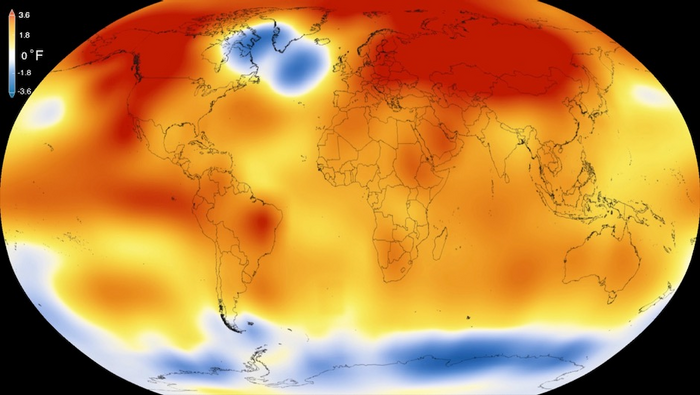According to a recent study from the University of Miami’s Rosenstiel School of Marine, Atmospheric, and Earth Science, the pattern of temperature change in the world’s oceans might not be an indication of a coming climate change catastrophe.

During the past century, the global surface temperature has been increasing, except a swath of region in the subpolar North Atlantic that is overall cooling, referred to as “warming hole.” Image Credit: NASA
UM Rosenstiel School researchers investigated a pattern of temperature change in a stretch of water in the subpolar North Atlantic region known as a warming hole, which has been cooling over the past century, using a cutting-edge climate model. This cooling has been attributed to a slowing of a planetary-scale ocean circulation known as the Atlantic meridional overturning circulation (AMOC), which transfers energy to the North Atlantic.
However, our study shows the warming hole during the past century is unlikely due to a slowdown of the AMOC. Instead, the warming hole is actually a consequence of human driven changes in the atmosphere. Our finding suggest that this warming hole will not result in an abrupt climate change event lethal to humans as depicted in Hollywood movies.
Chengfei He, Postdoctoral Researcher, Department of Atmospheric Sciences, Rosenstiel School, University of Miami
Geological records, like the Greenland ice core, have shown that the majority of sudden climate changes in Earth’s past were caused by a slowing of the AMOC.
The warming hole is believed as a fingerprint of the AMOC in present day. Its appearance suggests the AMOC may not be stable. Our results do not support this idea.
Amy Clement, Study Co-Author and Professor, Department of Atmospheric Sciences, Rosenstiel School, University of Miami
The investigators employed a digital Earth that can simulate historical climate change and forecast future climate change as their climate model. He and his coauthors set up the model with a motionless ocean for this investigation to analyze how the North Atlantic temperature reacts to changes in the atmosphere brought on by greenhouse gas and aerosol emissions.
As the ocean has no circulation, any change in the temperature of the ocean’s surface depends on the atmosphere above.
The atmospheric westerlies travel northward with global warming, enhancing the local wind across the subpolar North Atlantic and causing the warming hole.
The authors state, “This cooling trend is partially compensated by the warming due to the rise of greenhouse gases and the damping effect in sea surface temperatures.”
This research enhances the capacity to identify patterns of change in the ocean to various variables and the ability to predict how the ocean will change in the future.
The research was published in the Geophysical Research Letters journal. The authors include Chengfei He, Amy Clement, Lisa Murphy, Tyler Mitchell Fenske from the UM Rosenstiel School; Mark Cane from Columbia University, and Jeremy Klevans from the University of Colorado Boulder.
The study was aided by NOAA Grant NA20OAR4310400, NSF Climate and Large-Scale Dynamics Grants AGS 1735245 and AGS 1650209, and NSF P2C2 Grant AGS 1703076.
Journal Reference:
He, C., et al. (2022) A North Atlantic Warming Hole Without Ocean Circulation. Geophysical Research Letters. doi.org/10.1029/2022GL100420.